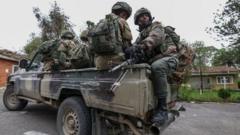Following tense negotiations, Israel and Hamas have reached a provisional consensus on a cease-fire agreement, pending final ratification and technical specifics. The initial phase proposes the exchange of hostages for Palestinian prisoners, but issues remain.
Israel and Hamas Move Toward Cease-Fire Agreement After Challenging Talks

Israel and Hamas Move Toward Cease-Fire Agreement After Challenging Talks
Provisional outline agreed upon by negotiators may result in the release of hostages and Palestinian prisoners amid ongoing conflict.
In a significant development in the ongoing conflict, negotiators from Israel and Hamas have tentatively agreed on a cease-fire framework for Gaza, though details regarding its initiation and other logistical concerns have yet to be finalized. Reports from senior officials involved in the mediation process hint that the agreement, which is crucial for peace after relentless fighting, could lead to the release of dozens of Israeli hostages held by Hamas in exchange for hundreds of Palestinians detained in Israel.
As tensions run high, the plan now awaits formal approval from the Israeli cabinet. However, conflicting viewpoints within Israeli leadership could present hurdles. Negotiations have progressed following the involvement of mediators, namely Egypt and the United States, and recent conversations reportedly have resolved some disagreements, casting a glimmer of hope for a cease-fire.
While the full details of the agreement remain unratified, it has been suggested that the terms will mirror earlier proposals made by the U.S. government. These include phased releases of hostages and humanitarian aid flow into Gaza amid regions affected by extensive destruction over the past year. Hurdles still stand in the way, including mapping military redeployments and addressing the political concerns surrounding the Egypt-Gaza border, which is critical for the execution of any peace deal.
Both sides have proceeded cautiously, with reports indicating that Hamas is working to secure the required consent from its leadership in Gaza, a move essential for the cease-fire to take effect. Meanwhile, voices within Israel's government remain divided over the speedy resolution of the complex situation, increasing the risks associated with the negotiations.
In a broader context, the ongoing talks reflect months of intermittent and inconclusive diplomatic efforts following a catastrophic escalation of violence initiated by Hamas's attacks on October 7, 2023. The spiral of attacks and retaliations has claimed tens of thousands of lives and compounded humanitarian challenges in the region, where aid and essential services have been severely disrupted.
Despite the cautious optimism from certain political circles about a potential agreement, the volatile nature of such negotiations means that Thomas may yet be at play. The outcome and future trajectory will depend not only on successful negotiations but also on the underlying political forces that shape the ambitions and actions of both Israel and Hamas.
As tensions run high, the plan now awaits formal approval from the Israeli cabinet. However, conflicting viewpoints within Israeli leadership could present hurdles. Negotiations have progressed following the involvement of mediators, namely Egypt and the United States, and recent conversations reportedly have resolved some disagreements, casting a glimmer of hope for a cease-fire.
While the full details of the agreement remain unratified, it has been suggested that the terms will mirror earlier proposals made by the U.S. government. These include phased releases of hostages and humanitarian aid flow into Gaza amid regions affected by extensive destruction over the past year. Hurdles still stand in the way, including mapping military redeployments and addressing the political concerns surrounding the Egypt-Gaza border, which is critical for the execution of any peace deal.
Both sides have proceeded cautiously, with reports indicating that Hamas is working to secure the required consent from its leadership in Gaza, a move essential for the cease-fire to take effect. Meanwhile, voices within Israel's government remain divided over the speedy resolution of the complex situation, increasing the risks associated with the negotiations.
In a broader context, the ongoing talks reflect months of intermittent and inconclusive diplomatic efforts following a catastrophic escalation of violence initiated by Hamas's attacks on October 7, 2023. The spiral of attacks and retaliations has claimed tens of thousands of lives and compounded humanitarian challenges in the region, where aid and essential services have been severely disrupted.
Despite the cautious optimism from certain political circles about a potential agreement, the volatile nature of such negotiations means that Thomas may yet be at play. The outcome and future trajectory will depend not only on successful negotiations but also on the underlying political forces that shape the ambitions and actions of both Israel and Hamas.






















